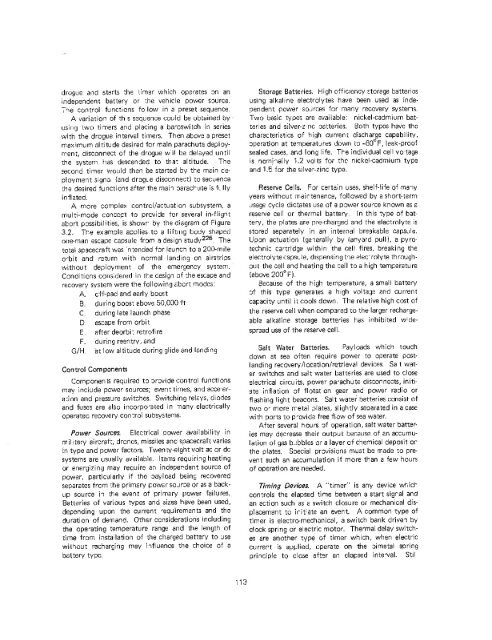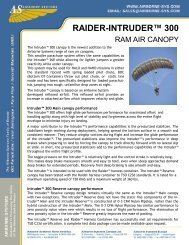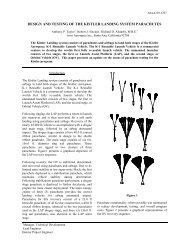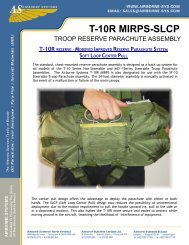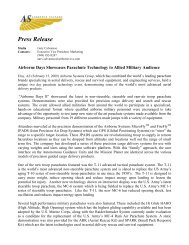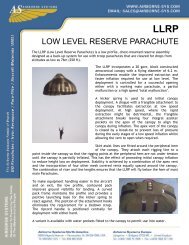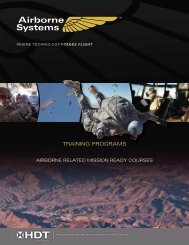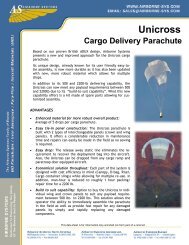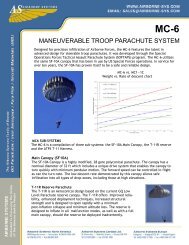"lfk f; \"A Lt. - Airborne Systems
"lfk f; \"A Lt. - Airborne Systems
"lfk f; \"A Lt. - Airborne Systems
You also want an ePaper? Increase the reach of your titles
YUMPU automatically turns print PDFs into web optimized ePapers that Google loves.
drogue and starts the timer which operates :m an<br />
independent battery or :he vehicle power saurcs.<br />
if1e control functions fo low in a preset sequence.<br />
A variation of th s s,:oquence could be uutCJined by<br />
lIsin\) Lwo timers and placing a baroswitch in series<br />
with the drogue interval timers. Then above a preset<br />
max imu m 01 ti tu de desi red for main parachute deployrrent,<br />
disconnect of the drogue wll be delayed until<br />
the system has descended to the: altitude. The<br />
second timer would then be started by the main ceployment<br />
signD (and dr8gLe disccnnect) to seCLlence<br />
the desired fu nctions after the mai'l aaraehlte is fL lIy<br />
inflated.<br />
\ more complex contrcl/actuation subsystem , a<br />
multi-mode eonccj:t to prcvi:e for sevel al in-fligrit<br />
abort possibilities. is showr by the diagram of Figure<br />
2. fr.e example applies to a lifting body shaped<br />
one-man escape capsule fram a design study226 The<br />
total spacecraft was ' ntended for leunc:, to a 20D-mile<br />
ocbit and return with normal landing on airstrips<br />
without deployment of the emergency system.<br />
Conditions cOfl3;dered in tt-,e cesign of :he escape and<br />
recovery system were the following ebort modes:<br />
A. eff-pad and early boo<br />
B. du ring boos: cbove 50 000 ft<br />
du ring late I aunch phase<br />
escape from orbit<br />
after deorbi, retrofi r8<br />
F. during reentry, and<br />
G/H at low altitude during glide and landing<br />
Control Components<br />
Componen ts requ ired t:J :Jr:Jvide control fu ncti ons<br />
may include power sources; event times, and acce' erfJ:lnn<br />
and pressure switches. Switching releys , diodes<br />
and fuses He also incorpocated in llany electrically<br />
operatea recovery conc.rol subsystems.<br />
Power Sources. Electrical power availability in<br />
mil itary aircraft, drenes, missiles anc spacecraft varies<br />
in type and power factors. Twenty-eight volt<br />
BC or de<br />
systems are usually avail8ble. Items requiri:lg heating<br />
or energizing may require an indeperdent source of<br />
power, particularly if tho :)ayload bein recovered<br />
sep8rates frcm the primc:ry j:OW6r SOJ r::e or as a backup<br />
source i' the e'Jent of primary power failures.<br />
Batteries of various types and sizes have been used,<br />
depending upon the cu rrent cequirements and the<br />
duration of demand. OthEr considerations including<br />
the ope'ating temperature range and the length of<br />
ti me from i nstai lati 011 of the charged battery to '.5e<br />
witilOUt recharging may hfluence the choice of a<br />
battery type.<br />
113<br />
Storage Batteries, High efflcloncy torage batteries<br />
using alkaline electrolytes have been used as inde.<br />
pendent power SOJrces for mClny recovery systens,<br />
Two basic types are available: nickel-cadmium batteries<br />
and silver-z' nc :)(Jtteries. Both types have the<br />
characteristics of hi h current discharge capabiiity.<br />
:Jperation at temperatures down to - , leak-proof<br />
sealed cases. and long life. TI-e individual cell votage<br />
is nomhally 1. 2 volts for the nickel-cadmium type<br />
and 1. 5 for the silvw- zinc type.<br />
Reserve Cells. For certain Llses, shelf.life of ma'lY<br />
years without iTairtenance, followed by a short-term<br />
Jsage ::ycle dictates use of a power sou cce known as 2<br />
reserve cell or thermcl battery In this type of bat-<br />
/ the plates are pre-charged 8nd the electrolyte is<br />
stored separately in an internal breakable capsule.<br />
Upcm actuation (ge1erally by larYi)rd pull , e pyrotechnic<br />
cartridge vvi th i n the cell fires, breaki ng tile<br />
electrolyte capsLle, dispensing t1e elec- rolyte throughout<br />
the Gell and heating the cell to a high temj:erature<br />
(above 200 F).<br />
Because of the r, igh temperature, a small battery<br />
Jt this type generates a high volta 2 And current<br />
capacity until it cools down. The relative high cost of<br />
the reserve cell when compared to tht: larger rechargeable<br />
alkaline storage batteries has inhibited videspraad<br />
use of the reserve cell.<br />
Salt Water Batteries. Payloads which touch<br />
down at sea otten require power to operate post.<br />
I andi ng recovery/I acati on/retrieval devices. Sa t water<br />
switches and solt water batteries are used to close<br />
electrical circuits. power pa:achute disconnects, initiate<br />
in'flation of flotat' on gear and power radio or<br />
fl ash ing I igh t beacons. Sal t water batteries consist of<br />
two 0' more rretal plates , slightly separated in a case<br />
with pons to p' ovide free flow of sea water.<br />
After several hours of operation , salt water batter-<br />
ies mal, decrease thei r outpu t because of an aCCL! mulaliurl<br />
of gas b..:bbles 01- a layer of chemical deposit or<br />
the plates. Soecial pr::JVisions must be made to prevent<br />
such an accumulation if more tr,an a few hours<br />
of operation are needed-<br />
Timing Devices. A " timer" is any device wh icr<br />
con:rols the elapsed time between a start sigral and<br />
an cction such as 2 switch closure or mechanical displacement<br />
to iritate an eve r. t. A common type of<br />
timer is electro-mechiJnical , a switch bank drivel by<br />
clock spring or electric motor. Thermal delay switches<br />
are another type of timer which, when electric<br />
currert is CJpr;lied, operate on the :Jimetal spring<br />
principle to close after an claj:sed inte'Val. Stil


